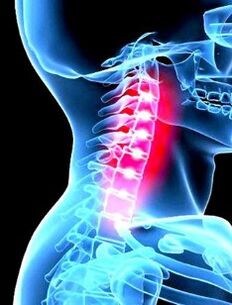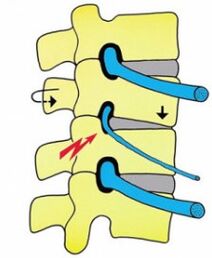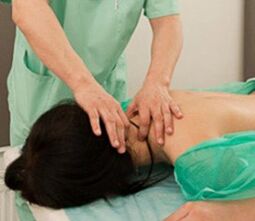Cervical osteochondrosis is a disease that is a dystrophic and degenerative diseases of the spine's neck slices. The cervix department is the most mobile, the muscle corset of this department in relation to others is much weaker. The neck carries out the rotation and inclination of the head, so that the spine in this area is exposed to deformations, destruction, hernia and curvature formations.

The main causes of the disease
It was found that osteochondrosis is an illness that "becomes young". Now this disease is increasingly being determined in people between the ages of 18 and 30, while cases of 40 were previously regarded as a norm. The reasons for this can be distinguished by the following:
- Violation of the attitude, the presence of a spine curvature according to the type of scoliosis, lordosis or kyphosis;
- Obesity, obesity;
- Back injuries;
- Metabolic disorder, low metabolism;
- Hard physical work;
- Hypodynamics, sitting lifestyle;
- weak physical training;
- nervous exhaustion, stress;
- Non -compliance with hygiene training for athletes;
- sharp ending of the training;
- Infectious diseases;
- Settlement of the body.
Osteochondrosis is essentially a consequence of muscle clamps, muscle pasmeness ultimately captivates the mobility of the cervical spine, increases the circulation of blood, increases blood supply to bones and muscle tissues, which provokes the development of dystrophic processes in crouches and vertebrae, the deterioration in interverted bralls. As a result, nerve roots and loss of sensitivity pressed.
Cervical osteochondrosis symptoms
The cervical osteochondrosis has a variety of symptoms. For the most part, the manifestation of osteochondrosis influences the circulatory system. There are many blood vessels in the cervix region that nourish the brain intensively. Therefore, the risk of osteochondrosis is associated with poor supply of the organs of the head, especially the brain. The segment, which has been defeated, is influenced by the segment. Therefore, the following signs of cervical osteochondrosis are differentiated:
- Root syndrome;
- Cardinal syndrome;
- Stimulus reflex syndromes;
- Syndrome of the arteries of vertebrae;
- The compression of the spinal cord.

What are the symptoms of cervical osteochondrosis if the Rooser syndrome is characteristic? Rooser syndrome in medicine is referred to as cervical radiculitis, it occurs due to nerves in the neck. Pain in the neck, go down into the zone of the shoulder blades, can be lower on the shoulder and forearm up to the fingers. In this case, the characteristic signs of cervical osteochondrosis are the experience of tingling, burning senses, the pastocity, the deafness of the hands, forearm or finger.
The symptoms of osteochondrosis of the cervix region have different regions that subdle the disease that influence their difference. In the event that the central nerve and its roots are affected, the pastose Middle, index and thumb will be. If the roots of the shoulder nerver were affected, the pastose is a little finger and a ring finger. Osteochondrosis of the cervical spine have the symptoms of the following syndrome as a stimulus reflex. The main feature will be the presence of acute, intensive, burning pain in the cervix area or in the throat itself. The pain increases during movement or loads, it is particularly acute according to a static state. For example after going to bed with inaccurate headlamps after sleep. The cervical osteochondrosis of the symptoms is similar because the pain when developing this syndrome is transferred to the chest. It is diagnosed in cases where the damage zone is not limited to the neck, but into the breast segment. The symptoms show a larger spectrum of cervical osteochondrosis. The most important thing is a violation of the work of the internal organs.
The syndrome of the spine artery - the worsening of the cervicalOsteochondrosis, the symptoms are extremely intense and consist of severe, burning pain. The pulsating pain in the temples, the presence of heavy migraines, which in particular surprise the parietal part, the back of the head and the region from the region of the Fronte are characteristic. The pain is chronic, constant, but sometimes they grasp cases of paroxysmal pain. The deterioration of the osteochondose of the cervical spine expresses symptoms in the form of increasing pain. This happens after they were serious physical exertion in unpleasant poses, with sudden movements. The deterioration threatens with auditory disorders - a vestibular disorder that experiences noise in the ears, as well as a decrease in hearing sharpness. Visual problems are not unusual. Osteochondrosis of the neck espionage symptoms with cardinal syndrome. Cardinal syndrome is characterized by heavy angina pectoris. It makes it difficult to identify the primary disease - osteochondrosis. The diagnosis "Osteochondrosis of the cervix region" is often carried out in good time because they try to diagnose angina pectoris and treat them. This endangers the transition of osteochondrosis into a chronic form.

The phenomenon of angina pectoris is provoked by pressing the spine in the lower segments of the cervix region that finds a reflex reaction. Cardinal syndrome can manifest itself in cases where the roots of the breast or diaphragm is irritated. Osteochondrosis of the symptoms of the cervical spine with the cardinal syndrome can be manifested in the form of tachycardia, extrasole. There are often cases in which osteochondrosis of the cervix region and high blood pressure is also continued together. Similarly, symptoms of a neck osteochondrosis symptoms symptoms, their treatment does not always appear in time, since doctors first diagnose cardiovascular diseases and not osteochondrosis.
Symptoms and treatment of cervical osteochondrosis
A certain syndrome is diagnosed from the dominance of certain symptoms, treatment is already carried out on the basis of it. The treatment is carried out in two ways: either radically, implies surgical intervention or a conservative method. In these cases, conservative treatment is not prescribed results for the company. Osteochondrosis of the cervix region is eliminated by the following methods:
- manual therapy;
- Massages, physiotherapeutic methods;
- Reflexotherapy - acupuncture;
- Medical treatment, pills;
- Water processes;
- Folk treatment methods;
- LFK courses and wellness gymnastics.
Cervical osteochondrosis symptoms treatment of tablet
Typically, drug treatment is prescribed in cases where the symptoms include the presence of severe pain. In fact, pills are not a panacea from the cause of pain - osteochondrosis itself. The tablets are also prescribed if the temperature for osteochondrosis of the cervical spine has increased. This symptom shows the presence of inflammatory processes in the body, inflammation of tissues and nerves must be eliminated.

Cervical osteochondrosis, symptoms, treatment and gymnastics
An effective and affordable treatment method is a complex for training therapy and gymnastics exercises. The exercises aim to increase the flexibility of the cervical spine and increase the discus distance, to strengthen the muscle corset that protects the spine from injuries and damage. In addition, gymnastics and exercises very effectively determine the functionality of the circulatory system, this not only promotes the bone tissue, but also enables us to normalize blood flow to the brain. The main thing is to carry out exercises under the supervision of a doctor.
Cervical osteochondrosis, symptoms and surgical treatment
In the event that conservative treatment did not provide any results, the operation is prescribed. It ensures the removal of processes, arches and ribbons and the removal of hernia that fell into the channel of the spine. According to this procedure, cases of the total instability of the cervix region are not unusual. After the operation, the patient is prescribed a special portable collar who stabilizes a weak neck and temporarily supported.
If you diagnose the disease in good time, you usually keep the strict recommendations of the doctor and lead comprehensive conservative therapy, then osteochondrosis is significantly adapted, in many cases a picture of full recovery is observed.



























